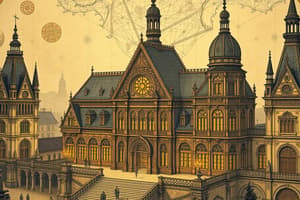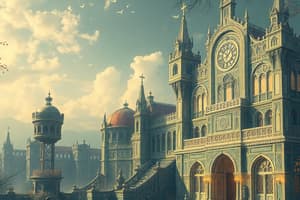Podcast
Questions and Answers
A geographer is studying the impact of a new highway on local businesses. Which branch of geography would this fall under?
A geographer is studying the impact of a new highway on local businesses. Which branch of geography would this fall under?
- Geomatics
- Human Geography (correct)
- Physical Geography
- Environmental Geography
Which of the following best describes the concept of 'place' in geography?
Which of the following best describes the concept of 'place' in geography?
- The relative location of a city to another city
- The movement of people and goods to a specific location
- The absolute coordinates of a location
- The human and physical characteristics that make a location unique (correct)
A map with a scale of 1:50,000 shows more detail than a map with a scale of 1:250,000. Why is this?
A map with a scale of 1:50,000 shows more detail than a map with a scale of 1:250,000. Why is this?
- Because the representative fraction is smaller on the 1:50,000 map.
- Because the representative fraction is larger on the 1:50,000 map. (correct)
- Because the verbal scale is easier to read on the 1:50,000 map.
- Because the graphic scale is longer on the 1:250,000 map.
A country has a high birth rate and a declining death rate. What is the MOST likely result?
A country has a high birth rate and a declining death rate. What is the MOST likely result?
Which economic sector is MOST closely associated with the extraction of natural resources?
Which economic sector is MOST closely associated with the extraction of natural resources?
Which of the following is a key factor contributing to urban sprawl?
Which of the following is a key factor contributing to urban sprawl?
What does the Human Development Index (HDI) measure?
What does the Human Development Index (HDI) measure?
Why are green revolutions controversial?
Why are green revolutions controversial?
Which type of map projection is MOST suitable for navigation because it preserves angles and shapes, though at the expense of area?
Which type of map projection is MOST suitable for navigation because it preserves angles and shapes, though at the expense of area?
A country is experiencing water scarcity due to climate change and overuse of resources. Which of the following strategies would BEST promote long-term sustainability?
A country is experiencing water scarcity due to climate change and overuse of resources. Which of the following strategies would BEST promote long-term sustainability?
Flashcards
What is Geography?
What is Geography?
The study of Earth's landscapes, people, places, and environments, bridging social and natural sciences to understand the world.
Location
Location
Absolute: Exact coordinates. Relative: Location in relation to other places.
Place
Place
Physical and human characteristics that make a spot on Earth unique.
Physical Geography
Physical Geography
Signup and view all the flashcards
Human Geography
Human Geography
Signup and view all the flashcards
What is GIS?
What is GIS?
Signup and view all the flashcards
Population Distribution
Population Distribution
Signup and view all the flashcards
Urbanization
Urbanization
Signup and view all the flashcards
Culture
Culture
Signup and view all the flashcards
Biodiversity
Biodiversity
Signup and view all the flashcards
Study Notes
- Geography is the study of the Earth's landscapes, peoples, places and environments
- It bridges the social and natural sciences
- Modern geography is an all-encompassing discipline that seeks to understand the world and our place in it
Key Concepts in Geography
- Location: Absolute (coordinates) and relative (in relation to other places)
- Place: Physical and human characteristics that make a location unique
- Human-Environment Interaction: How humans affect and are affected by their environment
- Movement: The flow of people, goods, and ideas
- Region: An area with shared characteristics
Branches of Geography
- Physical Geography: Studies natural processes of the Earth, such as climate, landforms, and ecosystems
- Human Geography: Studies human activities and their impact on the Earth, such as population, culture, and economics
- Environmental Geography: Studies the interactions between humans and the environment
- Geomatics: The use of technology (GIS, remote sensing, GPS) to analyze spatial data
Tools of Geography
- Maps: Visual representation of an area
- GIS (Geographic Information Systems): Computer systems for capturing, storing, analyzing, and displaying spatial data
- Remote Sensing: Acquiring information about the Earth's surface without physical contact (e.g., satellites, aerial photography)
- GPS (Global Positioning System): Satellite-based navigation system for determining locations
Population Geography
- Population Distribution: Pattern of where people live
- Population Density: Number of people per unit area
- Birth Rate: Number of live births per 1,000 people per year
- Death Rate: Number of deaths per 1,000 people per year
- Migration: Movement of people from one place to another
Economic Geography
- Primary Sector: Extraction of raw materials (e.g., agriculture, mining)
- Secondary Sector: Manufacturing and processing of raw materials
- Tertiary Sector: Services (e.g., retail, tourism)
- Quaternary Sector: Information and knowledge-based services (e.g., research, IT)
- Globalization: Increasing interconnectedness of countries through trade, investment, and cultural exchange
Urban Geography
- Urbanization: Growth of cities
- Urban Sprawl: Expansion of urban areas into surrounding rural areas
- Urban Morphology: The layout and structure of cities
- Central Business District (CBD): The commercial and business center of a city
- Gentrification: The renovation and redevelopment of deteriorated urban areas
Political Geography
- State: A defined territory with a government and population
- Nation: A group of people with a shared culture and identity
- Boundary: A line that separates one political unit from another
- Geopolitics: The study of the influence of geography on politics and international relations
- Electoral Geography: The study of the spatial aspects of voting patterns
Cultural Geography
- Culture: Shared beliefs, values, and practices of a group of people
- Cultural Region: An area with shared cultural traits
- Language: A system of communication
- Religion: A system of faith and worship
- Cultural Landscape: The visible imprint of human activity on the land
Environmental Geography
- Ecosystem: A community of living organisms and their physical environment
- Biodiversity: The variety of life in the world or in a particular habitat or ecosystem
- Climate Change: Long-term changes in temperature and weather patterns
- Deforestation: Clearing of forests
- Pollution: Contamination of the environment
- Sustainability: Meeting the needs of the present without compromising the ability of future generations to meet their own needs
Map Projections
- Mercator: Cylindrical projection, distorts area but preserves shape (good for navigation)
- Peters: Equal-area cylindrical projection, distorts shape but preserves area (good for thematic maps)
- Robinson: Compromise projection, balances shape and area distortions (good for general purpose maps)
Map Scale
- Representative Fraction: Ratio between distance on a map and the corresponding distance on the ground (e.g., 1:100,000)
- Verbal Scale: Expresses the relationship between map distance and ground distance in words (e.g., 1 inch equals 1 mile)
- Graphic Scale: Bar scale that shows the relationship between map distance and ground distance
Climate Zones
- Tropical: High temperatures and high precipitation year-round
- Temperate: Moderate temperatures and distinct seasons
- Polar: Cold temperatures year-round
- Arid: Dry with little precipitation
- Mediterranean: Warm, dry summers and mild, wet winters
Plate Tectonics
- Lithosphere: The Earth's rigid outer layer
- Asthenosphere: The plastic-like layer below the lithosphere
- Plate Boundaries: Areas where tectonic plates interact (convergent, divergent, transform)
- Earthquakes: Sudden release of energy in the Earth's crust
- Volcanoes: Ruptures in the Earth's crust where molten rock erupts
Development Geography
- Developed Countries: High levels of economic development, industrialization, and income
- Developing Countries: Lower levels of economic development, industrialization, and income
- Human Development Index (HDI): A measure of life expectancy, education, and income
- Gross Domestic Product (GDP): The total value of goods and services produced in a country in a year
- Inequality: Unequal distribution of resources and opportunities
Agricultural Geography
- Subsistence Farming: Growing enough food to feed oneself and one's family
- Commercial Farming: Growing crops or raising livestock for sale
- Green Revolution: Introduction of high-yielding crop varieties and modern agricultural techniques
- Genetically Modified Organisms (GMOs): Organisms whose genetic material has been altered
- Food Security: Having access to sufficient, safe, and nutritious food
Resources
- Renewable Resources: Resources that can be replenished (e.g., solar, wind, water)
- Non-Renewable Resources: Resources that cannot be replenished (e.g., fossil fuels, minerals)
- Resource Management: Managing resources sustainably
- Water Scarcity: Lack of sufficient water resources to meet demand
- Energy Transition: Shift from fossil fuels to renewable energy sources
Studying That Suits You
Use AI to generate personalized quizzes and flashcards to suit your learning preferences.




